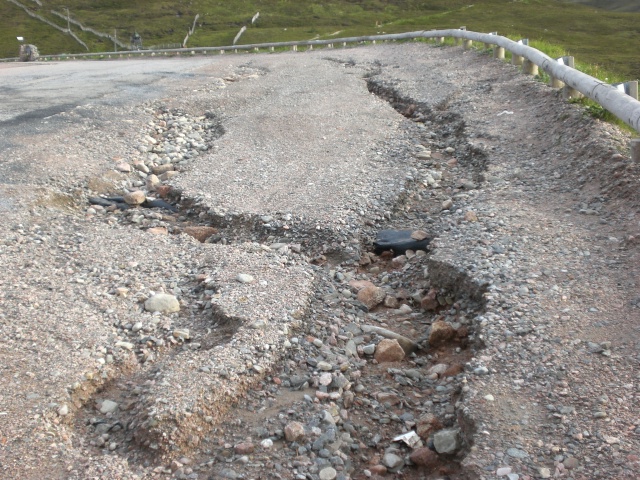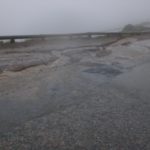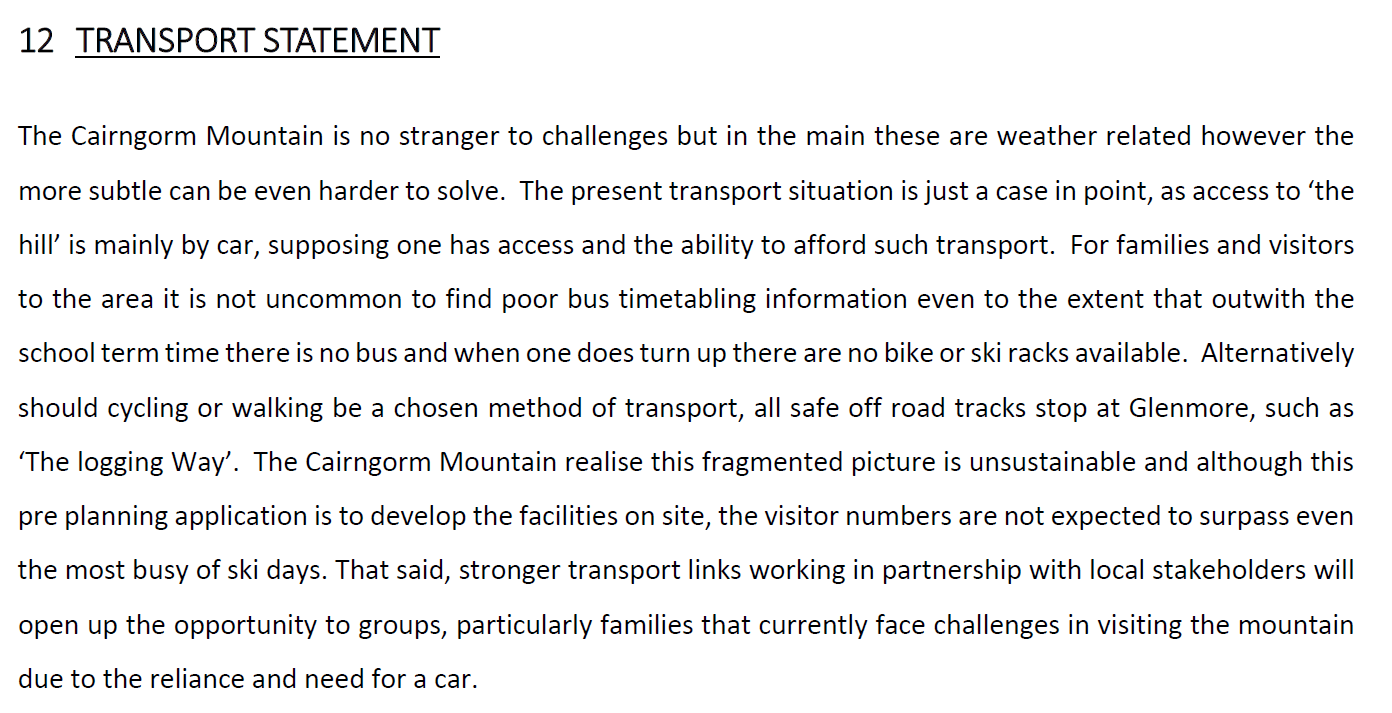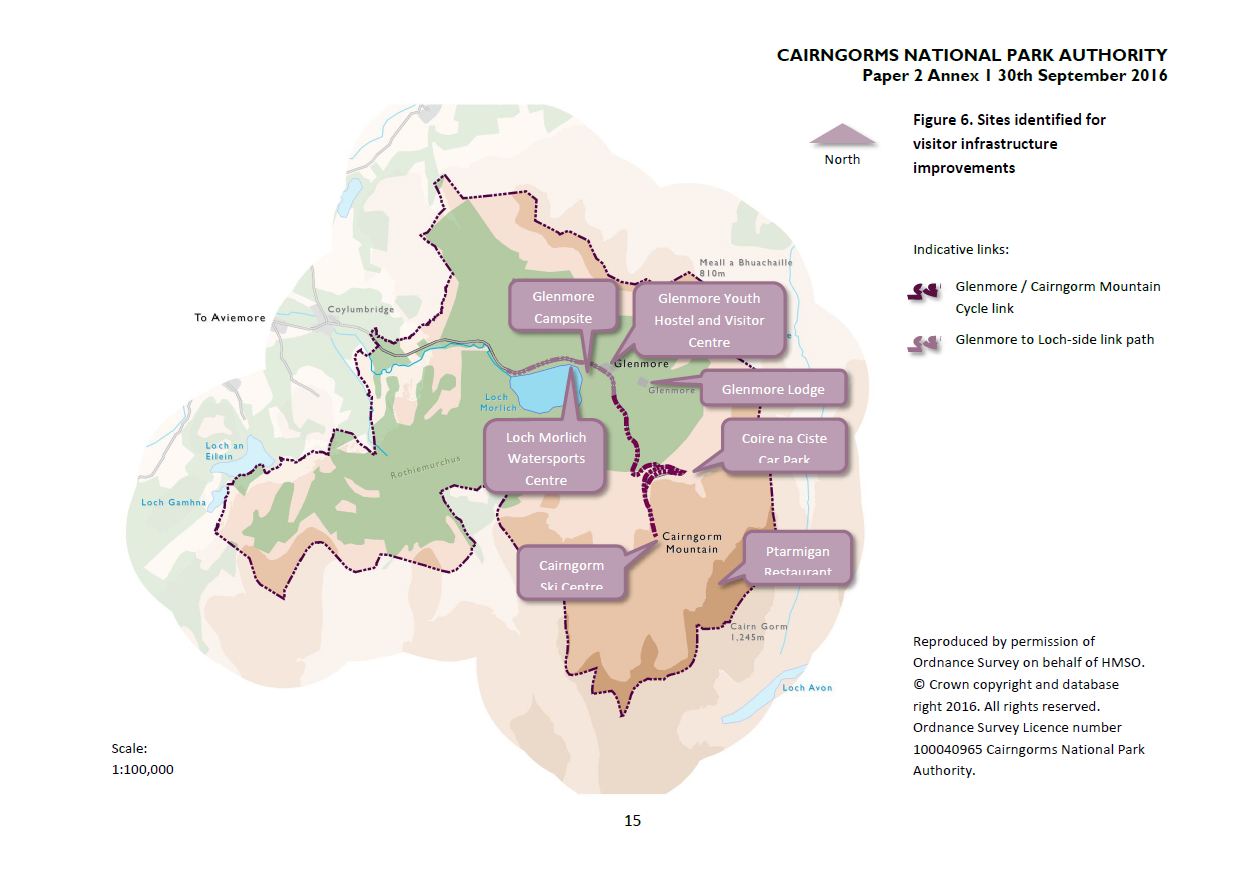
 Following the downpour at Cairngorm (see here and left) the photo above taken last week shows the impact of such flood events. While Natural Retreats and HIE’s recent mismanagement of Cairngorm has contributed to this, the problems go back much longer and the large car parks for example contribute to the rate that water runs off the hill. The motor car (which most people including this writer rely on for transport much of the time) has been central to the unsustainable development of Cairngorm ever since the ski road was constructed. As part of the Cairngorm masterplan (see here) Natural Retreats included a section on transport. The analysis and proposals in it are far more sensible than the Ptarmigan re-development or installation of snowflex artificial ski slopes above the Coire Cas carpark but do they offer a way forward?
Following the downpour at Cairngorm (see here and left) the photo above taken last week shows the impact of such flood events. While Natural Retreats and HIE’s recent mismanagement of Cairngorm has contributed to this, the problems go back much longer and the large car parks for example contribute to the rate that water runs off the hill. The motor car (which most people including this writer rely on for transport much of the time) has been central to the unsustainable development of Cairngorm ever since the ski road was constructed. As part of the Cairngorm masterplan (see here) Natural Retreats included a section on transport. The analysis and proposals in it are far more sensible than the Ptarmigan re-development or installation of snowflex artificial ski slopes above the Coire Cas carpark but do they offer a way forward?
Natural Retreats’s brief summary of the transport situation at Cairngorm, if you read past the marketing speak, is pretty damning:

Poor public transport, no imaginative solutions such as those used in the Alps (where school buses are used to transport people up valleys in the holidays), no bike or ski racks, a lack of path connections. So what are Natural Retreats’ solutions?

While there are some good ideas here the package has a whiff of self-interest. The short-term proposals should be easy to do, as they are all minor improvements, but could be read as a smokescreen for implementing parking charges at Cairngorm (which is one of HIE’s objectives). There is no information about how they, or more importantly the medium and long term proposals, could be financed despite the owner of Natural Retreats, David Michael Gorton, being extraordinarily rich – but then the way his companies are operating currently at Cairngorm is to take money out of the area rather than invest in it. Its not surprising therefore that the proposals such as hybrid buses, which the owner of Natural Retreats could afford to pay for now, have been scheduled as “Medium to Long Term”. There is no indication that he is going to invest anything that does not guarantee large immediate returns (like car park charges) or will not rely on the public sector to pay for everything while NR take the profit.
The proposals have been developed without any consultation. Under the Glenmore and Cairngorm Strategy, approved last year, Natural Retreats were supposed to be part of a Cairngorm & Glenmore Transport Working Group involving Highland Council, HITRANS, Forest Enterprise Scotland and the Cairngorms National Park Authority. Its not even clear whether this group has ever met let alone been and its telling that Natural Retreat’s refer to a slightly different group of stakeholders in the transport section of the masterplan including “the Glenmore Masterplan” (is this the same as the Cairngorm and Glenmore Strategy?), the CNPA, Cairngorms Connected and Active Cairngorms. In other words HIE’s and NR’s proposals don’t appear joined up with the plan developed by the CNPA. There are a couple of specific examples of this.
NR’s proposals make no reference to the action point in the Glenmore Strategy that there should be a “Feasibility study for improved public transport and park and ride approach”. So, does Natural Retreats support a feasibility study or not and will it contribute to the cost?
There is also no reference to the proposal for a new cycle route up to Cairngorm, the cycle link, as set out in the map below:
 On the other hand, HIE and NR have plucked out of a hat a new proposal for a “tourism train like that seen at Chamonix or York”. I am a fan of the Chamonix train – its free if you are staying in the valley – but to treat a back of a fag packet idea as a proposal without any consultation or working with other people on how it will be financed tells you everything you need to know about how NR and HIE operate.
On the other hand, HIE and NR have plucked out of a hat a new proposal for a “tourism train like that seen at Chamonix or York”. I am a fan of the Chamonix train – its free if you are staying in the valley – but to treat a back of a fag packet idea as a proposal without any consultation or working with other people on how it will be financed tells you everything you need to know about how NR and HIE operate.
What needs to happen
While some of NR’s proposals could support the objective of the Glenmore Strategy that, there should be “Improvements to transport and access infrastructure will increase public transport and non-motorised access to the area from Aviemore and beyond; and walking and cycling within the area”, they are unlikely to “Make a significant change in the way people access the area to increase the proportion of non-car access” because of the way they have been “developed”. Natural Retreats needs to start consulting the local community, business, visitors, conservation organisations and other stakeholders and to support structures set up in the National Park before it does anything else.

Assuming they mean the one from the city centre to the Rail Museum, the York “tourism train” charges £6 return, the distance is just over half a mile each way.